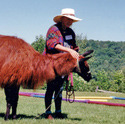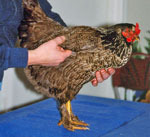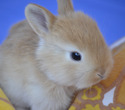Success Stories
Whether it’s the tiniest of creatures to the largest: from snake to salamander; elephant to emu; cat to cow; parakeet to primate, TTouch® can help!
Here are some of the many stories that people have shared with us.
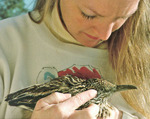
Bird
"I bought a medium Sulphur Crested Cockatoo six months ago who was a mess!! She was not tame or even the least bit friendly and had a few feathers missing. In six months, her feathers have filled in and though they are still not perfectly smooth I can now touch her and pet her and sometimes even pick her up. I decided to try the clouded leopard on her and WOW what a difference. I can now touch her everywhere, she even lifts her wings for me to touch her. She has even started coming to me every time I sit down, instead of when she feels like it. My stories are endless.
"I wish all people knew about TTouch®, please sent me all the information you can about becoming a practitioner, as I believe many could benefit from this work in my area.
"Thank you so very much." Cindy from Ontario, Canada

Building Trust
By Missy Parker, Veterinary Nurse
"One of the most beneficial things I've seen in a long time for building trust and calming is the Tellington "TTouch" therapy system, developed by Linda Tellington-Jones.
"In my capacity as a Registered Veterinary Nurse, I have used TTouch to prevent dogs from going into shock (yes, it really does work!) until the vet could get there to help the dog. In my capacity as an obedience instructor, I have used portions of it in my greeting (and subsequent handling) behaviors with scared dogs (as well as with aggressive ones) to build up their trust in me while calming them in a class situation. I have also used portions of it when I'm wearing my "mom" and "wife" hats to "create an atmosphere more conducive to cooperation."
"I've never told the humans I've used it on that it was developed for animals.However, Baylor Hospital of Dallas, Texas (which is a teaching hospital) is now using it on their human patients - and telling them it was developed for animals - so maybe it's time for me to come out of the closet!
"I've seen TTouch work wonders in every case in which it has been used properly. Four particular cases come to mind. The first is a Shiba Inu who would "short-circuit" in my obedience classes when the stimulation level got at all elevated. With just five to ten minutes of TTouch from his owner before each class, the dog did so much better!
"The second: my client, a very competent middle-aged woman, had never owned a dog before she adopted a female GSD stray. My best guess as to this dog's story is that she was either from Schutzhund lines or a washout from a police dog program, then neglected severely for quite a while afterward. She had heartworms and callouses on every pressure point from, I believe, lying in a concrete-bottom kennel.
"Heidi (the dog) was the most accomplished kennel escape artist I've ever dealt with ... she escaped mine five different ways before I figured out how to keep her in - she had both removed the gate from its hinges and bitten the gate lock in half. I just love this dog because I have learned so much from her! When she first started coming to my classes, Heidi would roar in dragging Cathy (the owner) as though she were an embarrassing ball-and-chain to be completely ignored. Now, after a few months of class, TTouch, and good management, Cathy has a much nicer dog - who adores her. Like many other dogs I've seen on TTouch regularly, Heidi can be gently reversed when she goes into overdrive, and quickly, by the application of as little as two minutes of TTouch touches.
"The third: Silver is a toy poodle who was genetically predetermined to be a yappy, snappy, shaky mess. She is now a fabulous therapy dog, solid at CD-level obedience, a joy to her owner and to everyone else with whom she comes in contact. TTouch is used in Silver's daily life in general and, specifically, before and after therapy sessions with challenging clients. By the will of her owner, with a little help from me, this dog has gone from "sow's ear to silk purse." By the way, Silver has only 20% vision in one eye and about 40% in the other; she will eventually go totally blind.
"The fourth case is my husband, who has back trouble - the pain sometimes makes him very "crabby." TTouch helps him feel better and consequently elevates his mood, which has the effect of making everyone in my house feel better!
"In classes, I begin with the Tarantula/Plow techniques. Even “extreme” dogs seem to enjoy it so much and/or are so curious about what I'm doing that they momentarily interrupt their agenda to ... eat the people, eat the other dogs, die of fright, whatever. Then, when I have their interested attention, I move to Noah's March. If all's still well, I use the Lying Leopard. All of this is done while toning.
"Years ago, when I was in hard labor, a female Labor Attendant did it on me - and it worked then, too - although she had no idea that what she was doing would years later be called the TTouch. Her technique was a super light touch, Clouded Leopard all over my straining belly while she softly sang “Rock of Ages” to me! It was incredibly helpful at a very stressful and painful time.
"The effect of regular TTouch use seems to be cumulative if these techniques are used with a subject regularly, his or her body’s autonomic responses seem to take over faster and faster each subsequent time.
"So, from my experience, I heartily recommend TTouch as a great addition to your instructor’s toolbox...and thanks to Terry Ryan for the term!
"Next time you have a bad headache, try it on yourself - it works that way too!"
- Missy Parker thunderridgeinc@juno.com
Missy continued:
"Tellington TTouch was born out of Linda's extraordinary lifetime of work with horses, and has now been adapted to many species other than equine, including dogs, cats, hamsters, and many exotic animals. Linda's four years of study with Dr. Moshe Feldenkrais, originator of the Feldenkrais method for horses, led her to the development of TTouch.
"Although TTouch is not technically a type of massage therapy, that would start to describe it. Actually, massage is done with the intent of affecting the muscular system - the intent of TTouch is the reorganizing of the nervous system and activating the function of the cells. I can describe it best by saying that it is a way of laying your fingers gently on the skin and moving them, as well as the skin they are touching, in a circular fashion, making repeating one-and-a-quarter circles clockwise. During this touch, the practitioner breathes rhythmically - in for the first half of the slow circle and out for the second half.
"According to Linda Tellington-Jones, TTouch is so simple to learn that a person having had less than one hour of instruction might make major changes in the behavior and personality of animals, and might considerably speed up the healing of wounds, injury or stiffness.
"Anna Wise, of the Evolving Institute of Boulder, Colorado, did a biofeedback study of TTouch practitioners which showed that both the brain waves of the practitioner, as well as those of the patient, were dramatically affected during the sessions. The brain waves registered what is known as "an awakened state" typical of healers, swamis, advanced meditators, and yogis as measured in a study by Maxwell Cate at the Institute for Psychobiological Research in London, England.
"There are several variations of TTouch hand positions; the amount of pressure used in the touch itself and where the touch is applied on the animal's body can vary, too. For instance, to prevent shock in injured animals of many species, as well as to calm the thunderstorm-phobic dog, T-Touch is applied to the ears.
"To make it easier to remember many of the hand/finger positions, they have been assigned the names of various animals: "Tarantula,” "Clouded Leopard,” "Flick of the Bear's Paw." With the TTouch, a practitioner may use "toning," a type of soothing vocalization.
"The Tellington TTouch Guidebook for Dogs describes the intended results of TTouch: to activate neural pathways to the brain, increasing an animal's self image and awareness, thereby improving its self-confidence and coordination. It adds: one need not know anatomy to be successful with this therapy, since using the TTouch anywhere on the body can improve health and awareness. Through the activation of its unused brain cells, an animal becomes more willing and able to learn. The TTouch develops a "cell-to-cell" between animal and human, a oneness which is a very special inter species, non-verbal communication."
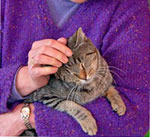
Cat
"My tortoise-shell cat really likes the TTouch®. It helped me change her from cat with an untouchable body to a cat who enjoys my contact. It worked. Thanks for your revolutionary work." - Helen Gordon
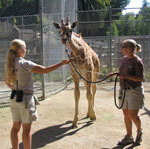
Giraffe
Using a Fusion of Operant Conditioning and Tellington Method to train Giraffe Calves
By Amy Phelps:and Melissa McCartney, Primary Keepers African Veldt –The Oakland Zoo

Goats
"Jaynellen Kovacevich, Tellington TTouch Practitioner has done brilliant work with the goats in Oakland's Zoo. Her Goat Ranger Program teaches teenagers to do TTouch on the petting-zoo animals and they have transformed the previously nibbly, skittish goats and sheep into peaceful, pettable beings. The trained teenage volunteers then teach visiting children how to TTouch and groom the goats. It is an interesting and successful program."
- Barbara Owens
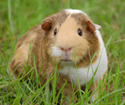
Guinea Pig and a Gold Fish
"When l saw The Tellington Touch on the bookstore shelf, I grabbed it and ran to the checkout line. Immediately, l read the book and practiced the technique on myself. My next step was to apply the TTouch on my guinea pig, a female who had become overweight after the weaning of her last litter. She had become lethargic, and due to inactivity, two of her legs became semi-paralyzed.
"I sat on the floor, book beside me, pig in my lap, and went to work, applying Raccoon touches all over her body, especially her back and legs. After about ten to fifteen minutes of touches and toning, she very calmly proceeded to walk down off my lap and onto the floor, where she sauntered around the living room!
"I was elated!! Had I actually done this? My husband was away, so I called him immediately and practically shouted the good news! Madelaine is still well, though she retains some stiffness, which I help with periodic TTouches. The other two guinea pigs also benefit from the technique. Now, my husband's ornamental goldfish are another thing altogether. Though they can not safely receive the TTouch directly, what I do is perform slow and deliberate Raccoon circles on the tank itself, all over it, and think, "feel" the fish as they float and swim. When I do this, they seem to slow their movements and a watch me. I have actually become quite close to one of them - a Black Moor named Kern - who always watches me and comes to me when l am by the tank. I will work further on this kind of "distant TTouch" and let you know what happens.
"I wanted you to know how important TTouch is to me and to my non human friends. Animals are the very heart and soul of me, and I want to dedicate my life to them, making their lives better, happier. With your help, TTouch, I am powerfully armed!"
- Carol Walle in West Lafayette, lD.
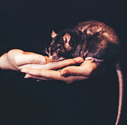
Pet Rat
"THEY ARE NEVER TOO SMAL! For the New Year, I treated myself to a pet rat (I had them in college). I'm from Brooklyn and we're pretty skeptical. but the TTouch proves itself.
"Three weeks ago, my rat was a wild, stressed-out little critter, crammed into a tiny fishtank with a dozen other rats, all destined for snake food.
"You can't imagine how dramatic and quick the change was. He just adores me. After I TTouch him, he repays the favor by grooming my hand. The weirdest thing is: I told him if he'd get housebroken, I'd let him live free in the bathroom. He's only missed the litter box once, so I've fulfilled my side of the deal. It's a little scary. I'm a mid-level corporate executive in Manhattan and I'm afraid a lot of people will think I'm nuts if I told them everything that is going on with this rat!"
- Donna
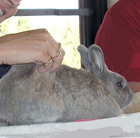
Rabbit
"I learned TTouch from my community service counselor at the Oakland Zoo. I am glad that I know TTouch because one of my employer's rabbit is old, so I practice 5-10 minutes of TTouch each day on him. I am actually surprised that the rabbit is thriving. TTouch is a magical thing."
- Sarah

Reindeer
"I had good luck with TTouch ears slides on a reindeer, five days old who was very cold when brought to us. I also did Abalone TTouches with a long drawn-out lift and circles with the whole leg with almost imaginary circles as he was very weak.
"I remembered doing imaginary python lifts on the python at the Vancouver Zoo. It really sunk in how subtle you can be if you start out that way. I'm glad to say this reindeer made it and was reunited with mom within 24 hours back at the reindeer ranch."
- Annie Tierney TTACT V Aspen, CO
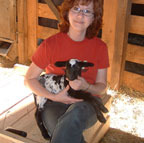
Sheep
Stressed ewe helped with ear TTouch!
"I just had to share a brilliant experience my daughter and I had today. We were walking our three dogs, miles from anywhere, and came across a field with sheep and lambs. In the middle of the field lay an ewe on its back with her legs in the air, unmoving. We had already been passed on the track by the farmer in his 4x4. We wondered: had he even noticed or made a mental note for later? So we paused to watch for signs of movement and there was absolutely none for several minutes. The rest of the flock ambled across the field to sniff her before moving away.
"It wouldn't be the first time I had pulled a cast sheep back onto its feet. but this time, feeling old, I sent my daughter over the fence to check for signs of life while I held the dogs. I got the thumbs up. and she grasped the heavy fleece and rolled the ewe over onto its front. However, even after several attempts the ewe could not get her feet underneath her. Eventually she did and staggered up. She had probably been there all night because we saw lots of droppings. She couldn't support her weight. Actually her body had gone very lopsided. So she fell onto her back again. At last Louise heard me yelling EARWORK.
"Louise proceeded to TTouch the ewe's ears for about ten minutes. The rest of the flock converged to watch. It was a brilliant moment when at last the ewe got to her feet and walked away, a little unsteadily at first. Her lamb, who had merged into the flock, returned to bleat at the ewe's foot. Then the ewe walked steadily around the perimeter of the field and the rest of the flock followed to investigate.
"We stayed to make sure she didn't go down again and about three-quarters of an hour later we arrived back at our car. I couldn't resist doing a detour and driving back up the track to the ewe's field. She was still upright waiting with the rest by the gate to be fed! Hurrah for TTouch!
- Barbara Cooper, Practitioner in England
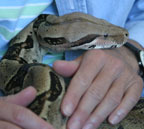
Snakes
"Hi all, One of my clients (human) breeds python snakes. He tells me that in every batch of snakes that hatches there are often a few that refuse to eat and have to be force fed (sometimes for up to a year before they will eat by themselves!).
"He brought some non-feeding babies for me to try TTouch with. One snake was 12 months old and four that were five weeks old. These babies are about the diameter of the average female ring finger, with heads about the size of a little finger fingernail. When I saw how small their heads were, my initial idea of doing TTouch circles on their mouths with a small artist's brush went out the window!
"What I did was initially stroke them from "neck" to tail with a soft artist's brush then changed to a large Sulfur cockatoo feather (compliments of my cockatoo Lily!) because I felt it had a more sensuous feel that I thought snakes would appreciate. At first, they were a bit edgy, but relaxed fairly quickly. I felt they enjoyed the feather stroking. I then started stroking further up towards their head and face and gradually was able to stroke them all over their faces without any sign of anxiety. I also tried sliding the feather under their bodies from "neck" to tail, hoping for a subtle belly lift effect.
"After a total of 20 minutes working on all five snakes, they seemed more comfortable with a little human contact (I figured because snakes are so sensitive, a feather or brush was a better choice initially since it wouldn't be mistaken for a predator).
"It remains to be seen whether this helps their feeding. I am hoping that having them feel more comfortable about something foreign (feather) around their face will lead to them being more comfortable about being offered food. I suspect stress is the key to the problem and will make up a homoeopathic/flower essence combination to be used on them as well."
- Carole Bryant in Oz berigora@nor.com.au

Squirrel
"I'd like to share with you my first experience I had using the TTouch method here at Hidden Acres Wildlife Rehabilitation Center in Oswego, N.Y.
"Late one evening this past summer we admitted an adult female gray squirrel who was hit by a car. She was in very poor condition. Her body was cold to the touch, there was blood coming out of her nose and half of her tail was missing. We administered the usual medications, but my gut feeling was that she was too far gone and was not going to pull through.
"Two months prior to this I had met Linda. We only had a short time together, but she did have enough time to teach me some TTouches. So, as I watched the lifelessness of this squirrel laying in front of me I thought, "Well, Linda showed me a little, I read all the literature she gave me, and in the condition of this squirrel is in, my attempt at TTouch couldn't do any harm."
"I started doing circles on both ears, as well as, gently pulling down the length of them. After doing this for 20 minutes, I then began doing circles all over her body. To my amazement she began to respond.
"For a week the squirrel had to be fed by putting her formula in a syringe with a caNula attached to it and slowly trickling it into her mouth. Before each feeding I would do small circles on her ears and then over her body. She always drank very well and remained calm. After 1 and 1/2 months, I released her in the woods at the Center.
"My opinion is that this squirrel healed more quickly than usual and that it was very easy to work with her during her treatment time. Usually wild squirrels get quite upset by your presence, but as long as I did TTouch with her first I could treat her. When I stopped doing TTouch for the three weeks prior to release she was very nasty and would lunge and scream at me when I went next to her cage.
"Since my experience with the squirrel I have used TTouch on several occasions. It seems to help get orphans to eat. Sometimes we get babies in who want nothing to do with the bottle. By making small circles on their lips, often times they will begin to suck.
"As a wildlife rehabilitator, I feel that the TTouch method can be of great value for both saving lives and shortening the animal’s length of stay due to faster healing. It has been my experience that TTouch also makes the animal easier to work with and this is a big advantage for people working with wild animals.
"The only problem I have run into is lack of time. At Hidden Acres we see over 600 animals a year and usually we are so rushed in the summer months to get everyone taken care of, that our own eating and sleeping seems to take a back seat. We are heavily, recruiting for dedicated volunteers, and as more join HAWRC we will be able to incorporate the use of the TTouch technique even during those busy times. I have seen and believe in the benefits, now comes the planning to fit TTouch into our daily lives
- Sincerely, Thea B. Wallace
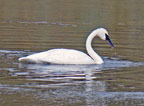
Swan
"A juvenile trumpeter swan was found by a fisherman at Minto Flats, west of Fairbanks, Alaska, with a badly broken wing from a gunshot. She was turned over to the U.S. Fish & WIldlife Service biologist, Rod King. His wife, Charlotte, is a wildlife rehabilitator.
"Because her condition was very poor, she was not expected to live. However, a vet in Fairbanks amputated her wing and gave her antibiotics. She was kept in Fairbanks for about two weeks then sent to me, a wildlife rehabilitator, for continued care. We named her Emily.
"While Emily would never fly again, she was important to her species. She was needed as a breeding bird for the restoration efforts in the mid-west states. Plans were made that she would be paired with another bird and when she nested in four to five years, her offspring would be allowed to fly free. Emily had a purpose and she needed help. Emily arrived at my place and was put in a covered pen because it would be at least two months before her feathers grew in over the surgical site and she became waterproof.
"Every time we went to feed or treat her, she would throw herself against the walls of the pen. We were concerned she would hurt herself. I had heard about TTouch and began to do little circles on Emily's neck and body once in a while. There was slight improvement in her reactions to our approach.
"In January Linda Tellington-Jones visited Emily. She worked the TTouch and visualization with her for about 45 minutes. I continued to work with Emily four times a week for the next three weeks. Emily's balance improved substantially, and she no longer ran away upon our approach. At the end of three weeks, we no longer needed to catch her to do TTouch. We would visualize circles and she would calm down, or we would visualize balance as she ran across the paddock flapping her remaining wing. Because of her missing wing, her balance was thrown off and she would fall over when she ran. After the TTouch work, she never fell over again.
"Emily continued to make progress and weighed in at a healthy 21 pounds six months after arrival at our place. Once her feathers became waterproof, she was turned out in the swan paddock with two captive-reared trumpeters, Bob and Julie. She became one of the group. Bob and Julie served as ambassadors to help their wild friend adjust to captivity and socialize with others of her kind.
"My husband, Michael, and I would take the swans down to the pond for swimming and bathing once a week. Emily learned to follow along. Once at the pond, she began to feed and bathe as a wild bird. She taught Bob and Julie how to dig in the banks for roots.
"We began to search in early summer to find Emily and other trumpeters permanent homes where they could be used for breeding. After several months it was determined that Sigfried would go to a facility in Michigan and Emily would go to the Canadian Ministry's breeding program in Ontario. It was a sad parting for us and a new beginning for them.
"Emily has adjusted well to her new home. I know that in a few years when she reaches breeding age, her cygnets will take wing and once again fill the skies with the sound of wild, free flying trumpeters.
- Martha Jordan. Tellington TTouch Practitioner
Tapir in Israeli Zoo
Linda TTouches a Tapir
By Daniela Zurr, DVM
"I invited Linda to the Nuernberg, Germany Zoo. It was a very special adventure for me to watch her interaction with zoo animals. It was fascinating to see how she tuned into the animal in such a short period of time and formed a connection. Meeting Daisy, a roughly 32-year-old tapir lady was especially touching for me.
"Daisy loves contact and scratches, and as long as her keeper is there it is fine for her to meet new people. Tapirs are built like tanks and have relatively thin and short legs, making them look rather clumsy. However, this first impression is not true, they can leap to their feet in a split second even after lying flat on their side. In the wild they are hunted by jaguars, so they have very tough and thick skin along their back and croup, it almost feels like a shell.
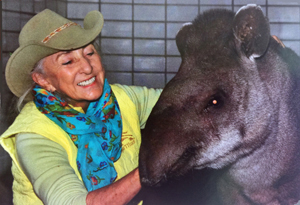 "It was fascinating to watch Daisy, a Tapir, with Linda. Usually Daisy lies down and falls asleep while being scratched. It was different with TTouch. Linda started working while Daisy was standing and she spent most of her time on her head, cheeks and side of her neck which Daisy seemed to really enjoy. After a few minutes Daisy sat down and all those who knew her expected her to lay down. But no, apparently the TTouches were far to interesting. Daisy stayed sitting during the entire session, and her face clearly showed her delight. She seemed to turn inward frequently and listened carefully to this unfamiliar sensation in her body. There was a bowl of tasty treats right in front of her feet during the entire session, but Daisy was far too busy enjoying the sensory input to even look at the morsels. Since that day when I see a tapir I think “ hard shell – soft inside” and I am reminded that the outside of an animal can be quite deceiving."
"It was fascinating to watch Daisy, a Tapir, with Linda. Usually Daisy lies down and falls asleep while being scratched. It was different with TTouch. Linda started working while Daisy was standing and she spent most of her time on her head, cheeks and side of her neck which Daisy seemed to really enjoy. After a few minutes Daisy sat down and all those who knew her expected her to lay down. But no, apparently the TTouches were far to interesting. Daisy stayed sitting during the entire session, and her face clearly showed her delight. She seemed to turn inward frequently and listened carefully to this unfamiliar sensation in her body. There was a bowl of tasty treats right in front of her feet during the entire session, but Daisy was far too busy enjoying the sensory input to even look at the morsels. Since that day when I see a tapir I think “ hard shell – soft inside” and I am reminded that the outside of an animal can be quite deceiving."
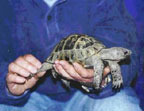
Turtle
"Myrtle the Turtle! It is surprising sometimes how we are introduced to animals who seem to choose the time and place. I was visiting a friend who has a wonderful outdoor pond full of fish, and a side area for turtles that her autistic son adopts - normally those in need of special care and friendship (another of the animal world wonders).
"Now, to continue my story, Myrtle was the largest of their painted turtles and attracted a hawk with her beautiful colors. The hawk swooped down and grabbed Myrtle in her talons. Myrtle was strong and obviously not ready to become dinner. By account, she seemingly struggled and bit the hawk, who immediately released her. She fell from a height equal to two two-story houses. At a glance there was something different. She had lost her left back leg and was in trauma from the fall. I just happened to visit on that afternoon.
"My first step was to check on her breathing and to stop the bleeding on the stump. Her breathing was ragged and was speeding and slowing, which, according to her owner was not normal for her. She showed no interest in eating or drinking and was not reacting to a stranger working with her. I began with the Lying Leopard on her shell as I did not want to overwhelm her by touching all of her shell. I left her for about five minutes to see what her reaction would be. She did not show any outward reaction, so I started the "Turtle TTouch" all over her shell, explaining to the owners, how it could calm Myrtle and stabilize her breathing and temperature. I also gave her Rescue Remedy.
"The bleeding on her leg had slowed significantly. (I had a Calendula homeopathic tincture and used it on her wound while working the TTouches). Her breathing became regular so we left her alone for about 1/2 an hour.
"She accepted small Raccoon touches on her other three legs, neck and tail. I soon was able to do VERY small Python lifts on her three legs and moved to where her other leg had been severed. It was hot to the touch, and I was particularly careful to be gentle with her, so the bleeding did not start again. For me, this was the first time I had worked on a phantom limb especially one so recent. It was phenomenal that once I began doing Noah's March at the end of the leg lifts - on all her legs - that she began to walk. And walk she did. It was almost as though she had been walking on three legs for ever! Her head and tail were out of her shell and she was interested in eating once again.
"At each step of the way, both my friend, and her son were interested in trying the TTouches on their other turtles. And they continued with Myrtle. The realization that she had recovered was a rare find a month or so later - turtle eggs!"
- Janice Fowles TTouch Practitioner-1 Ottawa, Ontario
